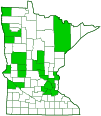Ballard’s goldenaster
(Heterotheca ballardii)
Conservation • Description • Habitat • Ecology • Use • Distribution • Taxonomy
|
|
|||||||||||||
Description |
Ballard’s goldenaster is an 8″ to 20″ tall, erect, perennial forb that rises on 1 to 50 or more stems from a long, deeply penetrating taproot. The stems are ascending to erect, sometimes reddish-brown, and sometimes whitish near the top. They are moderately to densely covered with straight, stiff, sharp, appressed hairs. They often have abundant long, coarse, stiff, spreading hairs. They do not have gland-tipped hairs. There are no basal leaves. Stem leaves are alternate and are not crowded. Lower stem leaves are inversely lance-shaped, ⅞″ to 1½″ long, and ⅛″ to 5 ⁄16″ wide. They are attached to the stem on short leaf stalks. The leaf blades are rounded at the base and broadly or moderately angled at the tip. There is sometimes a short, sharp, abrupt point at the tip. The upper and lower surfaces are moderately covered with straight, stiff, sharp, appressed hairs. The hairs are not dense enough to obscure the leaf surface. The surfaces do not have gland-tipped hairs. The margins are untoothed and flat, not wavy. There are straight, stiff, sharp, appressed hairs along the entire margin and sparse to abundant long, coarse, stiff, spreading hairs near the base. Lower stem leaves are usually absent at flowering time. Upper stem leaves are similar, oblong, ⅞″ to 1⅜″ long, and ⅛″ to ⅜″ wide, not becoming much smaller as they ascend the stem. The inflorescence is a cluster of 2 to 24, usually 4 to 16, flower heads at the end of each stem. The flower heads are 1″ to 1½″ wide. They are on ½″ to 1⅞″ long stalks that are moderately to densely rough hairy but have no glandular hairs. The flower heads are closely subtended by 1 to 7 or more inversely lance-shaped, leaf-like bracts. The bracts are often long enough to extend beyond the involucre. The whorl of bracts at the base of the flower head (involucre) is broadly bell-shaped and ¼″ to ⅜″ wide. There may be 12 to 30 yellow ray florets, averaging 21. The strap-like portion of the ray floret is usually ⅜″ to ⅝″ long. There are 10 to 85, usually 20 to 50, yellow disk florets. The fruit is a 1 ⁄16″ to ⅛″ long achene with 30 to 45 off-white bristles attached to the end. The achene is inversely cone-shaped, with the attachment at the narrow end, and has 4 to 10 ribs. |
Height |
8″ to 20″ |
Flower Color |
Yellow ray florets, yellow disk florets |
Similar Species |
Hairy false goldenaster (Heterotheca villosa var. minor) upper leaves are narrowly to broadly inversely lance-shaped or oblong. The upper and lower leaf surfaces are sparsely to moderately covered with gland-tipped hairs. The flower heads are subtended by 1 to 7 or more bracts that are greatly reduced in size, usually linear-oblong, and are not leaf-like. Hairy false goldenaster (Heterotheca villosa var. villosa) upper leaves are inversely lance-shaped. The flower heads are rarely subtended by bracts. When they are, those bracts are linear inversely lance-shaped, are greatly reduced in size, and are leaf-like. Leafy false goldenaster stems and leaves have gland-tipped hairs. The hairs on the leaf surfaces are dense enough to obscure the leaf surface. The bracts are often long enough to extend beyond the head. Stiffleaf false golden aster (Heterotheca angustifolia) leaves are densely crowded and are pale green to grayish-green. The flower heads are subtended by 1 to 3 leaf-like bracts. The flower head stalks are no more than ⅝″ long. |
Habitat |
Dry. Open places. Full sun. |
Ecology |
Flowering |
July to October |
Pests and Diseases |
|
Use |
|
Distribution |
||
|
Sources |
|
| 3/9/2024 | ||
Nativity |
||
Native |
||
Occurrence |
||
|
||
Taxonomy |
|
Kingdom |
|
Division |
Tracheophyta (Vascular Plants) |
Subdivision |
Spermatophytina (Seed Plants) |
Class |
|
Order |
Asterales (Sunflowers, Bellflowers, Fanflowers, and Allies) |
Family |
Asteraceae (Sunflowers, Daisies, Asters, and Allies) |
Subfamily |
Asteroideae |
Supertribe |
Asterodae |
Tribe |
Astereae (asters and allies) |
Subtribe |
Chrysopsidinae |
Genus |
Heterotheca (false goldenasters) |
Section |
Phyllotheca |
Subordinate Taxa |
|
|
|
Synonyms |
|
Chrysopsis ballardii Heterotheca villosa var. ballardii |
|
Common Names |
|
Ballard’s goldenaster Ballard’s hairy false goldenaster hairy false goldenaster |
|
Glossary
Achene
A dry, one-chambered, single-seeded seed capsule, formed from a single carpel, with the seed attached to the membranous outer layer (wall) only by the seed stalk; the wall, formed entirely from the wall of the superior ovary, does not split open at maturity, but relies on decay or predation to release the contents.
Glandular hairs
Hairs spread over aerial vegetation that secrete essential oils. The oils act to protect against herbivores and pathogens or, when on a flower part, attract pollinators. The hairs have a sticky or oily feel.
Involucre
A whorl of bracts beneath or surrounding a flower, flower head, or flower cluster.
Visitor Photos |
||
Share your photo of this plant. |
||
This button not working for you? |
||
|
||
|
||
MinnesotaSeasons.com Photos |
||

Slideshows |
|

Visitor Videos |
||
Share your video of this plant. |
||
This button not working for you? |
||
|
Other Videos |
||
|

Visitor Sightings |
||
Report a sighting of this plant. |
||
This button not working for you? |
||
|
|
MinnesotaSeasons.com Sightings |
||
|

Created: Last Updated: © MinnesotaSeasons.com. All rights reserved. |
